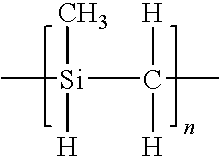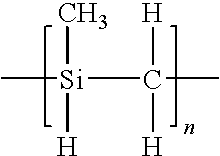Powder metallurgical compositions containing organometallic lubricants
a technology of organometallic lubricants and powder compositions, which is applied in the field of powder compositions, can solve the problems of reducing the green strength affecting the bonding of particles and particles, and the shape cannot be pressed using known internal lubricants, so as to reduce the internal friction between base metal particles, improve the physical properties of the compacted part, and reduce the force necessary
- Summary
- Abstract
- Description
- Claims
- Application Information
AI Technical Summary
Benefits of technology
Problems solved by technology
Method used
Image
Examples
example 1
[0077]Metallurgical powder compositions composed of an organometallic lubricant were evaluated and compared to a reference powder composed of a conventional organic lubricant. Reference Composition I was prepared by admixing a prealloyed iron based powder and 0.75 weight percent of a conventional ethylene bis-stearamide wax lubricant (commercially available as Acrawax, from Glycol Chemical Co.). The prealloyed iron based powder included iron with 0.35 weight percent silicon, 4.4 weight percent nickel, 0.6 weight percent carbon (commercially available as Ancorloy MDC-L, from Hoeganaes Corp.).
[0078]Test Composition I was prepared by solvent bonding a prealloyed iron based powder with 0.75 weight percent of an organometallic lubricant, 4.4 weight percent nickel alloying powder (commercially available as “Inco 123” powder from Inco Limited), and 0.6 weight percent of graphite powder (commercially available as 3203 graphite, from Asbury Graphite Mills). The prealloyed iron based powder i...
example 2
[0082]Metallurgical powder compositions composed of an organometallic lubricant were compacted at various temperatures and compared to a reference powder composed of a conventional organic lubricant. Test Composition III was prepared the same as Test Composition I except that 0.55 weight percent graphite powder was utilized. Bars of Test composition III and Reference Composition I were compacted at a pressure of 50 tsi at room temperature, 145° F., and 170° F. Powder properties and green physical properties are shown in Table 2:
[0083]
TABLE 2Test Comp.TestTestReferenceIIIComp. IIIComp. IIIComposition I(Room Temp.)(145° F.)(170° F.)(Room Temp.)Apparent2.752.752.753.2Density (g / cc)Flow30.730.730.729.4(Sec / 50 g)Green Density7.087.147.207.20(g / cc)Green2200280042001800Strength (psi)Green0.190.170.100.13Expansion (%)Strip Pressure3600270035002800(psi)Slide Pressure4400210040002000(psi)
[0084]When pressed at 170 degrees Fahrenheit, metallurgical powder compositions composed of organometallic...
example 3
[0085]Metallurgical powder compositions composed of an organometallic lubricant were evaluated at different sintering temperatures and compared to a reference powder composed of a conventional organic lubricant. Test Composition III and Reference Composition I, as described above, were compacted at a pressure of 50 tsi and at a temperature of 170° F. The compacted bars were then sintered at 2150° and 2250° F. and tempered at 400° F. as set out above. Green and sintered physical properties of are shown in Table 3:
[0086]
TABLE 3TestReferenceTestReferenceComp. IIIComposition IComp. IIIComposition I(2150° F.)(2150° F.)(2250° F.)(2250° F.)Green Density7.227.187.227.19(g / cc)Green0.110.140.120.14Expansion (%)Sintered7.317.247.327.26Density (g / cc)Dimensional−0.33−0.27−0.41−0.35Change (%)Weight Loss0.390.900.420.88(%)Transverse299295327319RuptureStrength (Ksi)Hardness RA65.663.965.564.7
[0087]As shown in Table 3, metallurgical powder compositions composed of organometallic powders exhibited hi...
PUM
| Property | Measurement | Unit |
|---|---|---|
| weight percent | aaaaa | aaaaa |
| weight percent | aaaaa | aaaaa |
| temperature | aaaaa | aaaaa |
Abstract
Description
Claims
Application Information
 Login to View More
Login to View More - R&D
- Intellectual Property
- Life Sciences
- Materials
- Tech Scout
- Unparalleled Data Quality
- Higher Quality Content
- 60% Fewer Hallucinations
Browse by: Latest US Patents, China's latest patents, Technical Efficacy Thesaurus, Application Domain, Technology Topic, Popular Technical Reports.
© 2025 PatSnap. All rights reserved.Legal|Privacy policy|Modern Slavery Act Transparency Statement|Sitemap|About US| Contact US: help@patsnap.com



